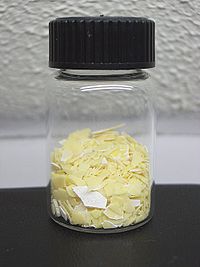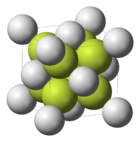- Sodium sulfide
-
Sodium sulfide  Other namesDisodium sulfide
Other namesDisodium sulfideIdentifiers CAS number 1313-82-2  ,
,
1313-84-4 (pentahydrate)
1313-84-4 (nonahydrate)PubChem 237873 EC number 215-211-5 UN number 1385 (anhydrous)
1849 (hydrate)RTECS number WE1905000 Properties Molecular formula Na2S Molar mass 78.0452 g/mol (anhydrous)
240.18 g/mol (nonahydrate)Appearance colorless, hygroscopic solid Density 1.856 g/cm3 (anhydrous)
1.58 g/cm3 (pentahydrate)
1.43 g/cm3 (nonohydrate)Melting point 1176 °C (anhydrous)
100 °C (pentahydrate)
50 °C (nonhydrate)Solubility in water 186 g/L (20 °C)
390 g/L (50 °C)Solubility insoluble in ether
slightly soluble in alcoholStructure Crystal structure Antifluorite (cubic), cF12 Space group Fm3m, No. 225 Coordination
geometryTetrahedral (Na+); cubic (S2–) Hazards MSDS ICSC 1047 EU Index 016-009-00-8 EU classification Corrosive (C)
Dangerous for the environment (N)R-phrases R31, R34, R50 S-phrases (S1/2), S26, S45, S61 NFPA 704 Autoignition
temperature>480 ºC Related compounds Other anions Sodium oxide
Sodium selenide
Sodium tellurideOther cations Lithium sulfide
Potassium sulfideRelated compounds Sodium hydrosulfide  sulfide (verify) (what is:
sulfide (verify) (what is:  /
/ ?)
?)
Except where noted otherwise, data are given for materials in their standard state (at 25 °C, 100 kPa)Infobox references Sodium sulfide is the name used to refer to the chemical compound Na2S, but more commonly it refers to the hydrate Na2S·9H2O. Both are colorless water-soluble salts that give strongly alkaline solutions. When exposed to moist air, Na2S and its hydrates emit hydrogen sulfide, which smells much like rotten eggs or flatus. Generally, commercially available sodium sulfide is not a unique chemical entity, but it is specified as Na2S·xH2O, where a weight percentage of Na2S is specified. Commonly available grades have around 60% Na2S by weight, which means that x is around 3. Such technical grades of sodium sulfide have a yellow appearance. These grades of sodium sulfide are marketed as 'sodium sulfide flakes'. Although the solid is yellow, solutions of it are colorless.
Contents
Structure
Na2S adopts the antifluorite structure,[1][2] which means that the Na+ centers occupy sites of the fluoride in the CaF2 framework, and the larger S2− occupy the sites for Ca2+. In solution, the salt, by definition, dissociates. The dianion S2− does not, however, exist in appreciable amounts in water. Sulfide is too strong a base to coexist with water. Thus, the dissolution process can be described as follows:
- Na2S(s) + H2O(l) → 2Na+(aq) + HS− + OH−
Sodium sulfide can oxidize when heated to sodium carbonate and sulfur dioxide:
- 2 Na2S + 3 O2 + 2 CO2 → 2 Na2CO3 + 2 SO2
Production
Industrially Na2S is produced by reduction of Na2SO4 with carbon, in the form of coal:[3]
- Na2SO4 + 4 C → Na2S + 4 CO
In the laboratory, the anhydrous salt can be prepared by reduction of sulfur with sodium in anhydrous ammonia. Alternatively, sulfur can be reduced by sodium in dry THF with a catalytic amount of naphthalene:[4]
- 2 Na + S → Na2S
Uses
It is primarily used in pulp and paper industry in the kraft process . It is used in water treatment as an oxygen scavenger agent, in the photographic industry to protect developer solutions from oxidation, in textile industry as a bleaching, as a desulfurising and as a dechlorinating agent and in leather trade for the sulfitisation of tanning extracts. It is used in chemical manufacturing as a sulfonation and sulfomethylation agent. It is used in the production of rubber chemicals, sulfur dyes and other chemical compounds. It is used in other applications including ore flotation, oil recovery, food preservative, making dyes, and detergent.
Safety
Like sodium hydroxide, sodium sulfide is strongly alkaline and can cause skin burns. Acids react with it to rapidly produce hydrogen sulfide, which is a toxic and foul-smelling gas.
References
- ^ Zintl, E; Harder, A; Dauth, B. (1934). "Gitterstruktur der oxyde, sulfide, selenide und telluride des lithiums, natriums und kaliums". Z. Elektrochem. Angew. Phys. Chem. 40: 588–93.
- ^ Wells, A.F. (1984) Structural Inorganic Chemistry, Oxford: Clarendon Press. ISBN 0-19-855370-6.
- ^ Holleman, A. F.; Wiberg, E. "Inorganic Chemistry" Academic Press: San Diego, 2001. ISBN 0-12-352651-5.
- ^ So, J.-H; Boudjouk, P; Hong, Harry H.; Weber, William P. (1992). "Hexamethyldisilathiane". Inorg. Synth.. Inorganic Syntheses 29: 30. doi:10.1002/9780470132609.ch11. ISBN 9780470132609.
External links
- chemicalland21.com Sodium sulfide.
Sodium compounds NaAlO2 · NaBH3(CN) · NaBH4 · NaBr · NaBrO3 · NaCH3COO · NaCN · NaC6H5CO2 · NaC6H4(OH)CO2 · NaCl · NaClO · NaClO2 · NaClO3 · NaClO4 · NaF · NaH · NaHCO3 · NaHSO3 · NaHSO4 · NaI · NaIO3 · NaIO4 · NaMnO4 · NaNH2 · NaNO2 · NaNO3 · NaN3 · NaOH · NaO2 · NaPO2H2 · NaReO4 · NaSCN · NaSH · NaTcO4 · NaVO3 · Na2CO3 · Na2C2O4 · Na2CrO4 · Na2Cr2O7 · Na2MnO4 · Na2MoO4 · Na2O · Na2O2 · Na2O(UO3)2 · Na2S · Na2SO3 · Na2SO4 · Na2S2O3 · Na2S2O4 · Na2S2O5 · Na2S2O6 · Na2S2O7 · Na2S2O8 · Na2Se · Na2SeO3 · Na2SeO4 · Na2SiO3 · Na2Te · Na2TeO3 · Na2Ti3O7 · Na2U2O7 · NaWO4 · Na2Zn(OH)4 · Na3N · Na3P · Na3VO4 · Na4Fe(CN)6 · Na5P3O10 · NaBiO3
Categories:- Sulfides
- Sodium compounds
- Photographic chemicals
- Inorganic compound stubs
Wikimedia Foundation. 2010.


